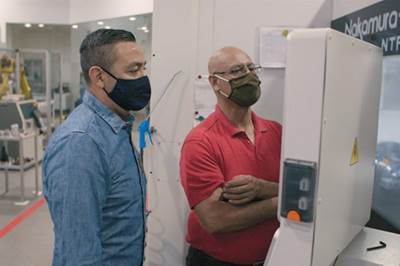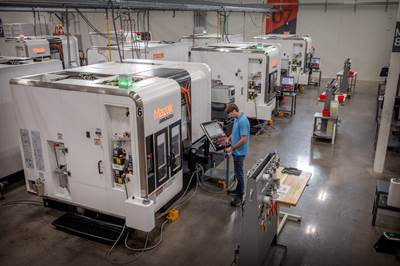Share



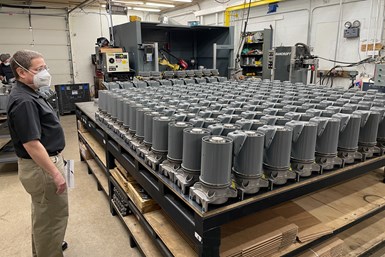
MTH Pumps’ assembly area currently doubles as a storage area for completed Freon pumps. The company’s robotic welding cells (visible in the back) not only automate the assembly process, they also conduct operations that would be impossible by hand.
MTH Pumps is filled to capacity. The Plano, Illinois, pump OEM has outfitted its shop floor and adjacent building with machine tools, storage racks, quality control devices, welding robots and more. Spatially limited in its ability to expand its fleet of machines to meet skyrocketing customer demand, the company is turning to a series of creative solutions — including but not limited to automation — to increase productivity and throughput.
Adding machine-tending robots to its Mazak Integrex multitasking machines was the first step along the company’s automation journey, but meeting increased customer demands has also required a series of process refinements and strategies around redundant machines and tooling, process repeatability and bespoke part-staging setups. These strategies have not only allowed MTH Pumps to ramp up production and achieve lights-out automation, they have done so without reliance on heavy expenditures toward capital equipment.
Boilers, Chillers and Freon
MTH Pumps first opened its doors in 1965. Second-generation owner Tim Tremain cut his teeth with the company in the 1980’s, and has been on the forefront of the company’s automation efforts since programming a two-pallet horizontal machining center at the start of his career.
The company uses castings to create more than 3,000 part numbers, though the bulk of its work involves variations of three parts for the company’s line of regenerative turbine pumps. These pumps are comprised of casings (consisting of cover and motor bracket components) and impellers, with rings for multi-stage pumps. The casings are typically bronze, stainless steel or cast iron, while the impellers are commonly made of bronze or a high-nickel ASTM A494 alloy. While demand for these pumps has been steady across the longstanding boiler feed and chiller markets, MTH has seen a massive uptick in demand for sealless versions of its pumps for computer data centers and other customers using Freon cooling systems.
Even on parts without the zero-seal requirement, many of MTH’s machined parts need to hold extreme tolerances, such as its impellers that require 0.0005” tolerances for perpendicularity, parallelism and flatness at thicknesses of 0.082”. In 2006, the company’s drive toward improved quality led it to purchase its first turn-mill, a used Mazak Integrex 200-IIIST, to counteract the holdups and inaccuracies resulting from transfering parts between machines. While moving parts between spindles in the Integrex still requires multiple chuckings, Tremain says the automated nature of the second chucking makes the multitasking machine “an order of magnitude” better for quality than the hand-loaded positioning and hand-tightened clamping devices of the HMCs and lathes previously used by the company.
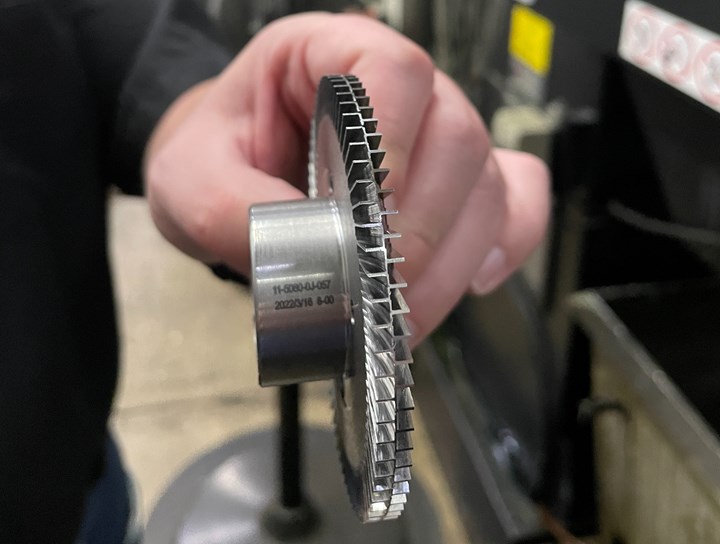
“The impeller is the heart of the pump,” Tremain says. But the impeller’s ubiquity doesn’t make its 0.0005” perpendicularity and parallelism tolerances any simpler to machine, especially at a thickness of 0.082”. The Integrex machines must mill vanes on each side separately without disrupting the perpendicularity-parallelism tolerance relationship.
MTH’s first Integrex machine made such a difference to the company’s processes that the OEM gradually replaced the bulk of its single-operation machines with 12 Integrex multi-tasking machines of various sizes and eras. Each of these machines includes built-in automation features such as deburring brushes and three-axis gantry robots. The company has also paired one of its machines with a six-axis machine-tending robot from Agile Robotic Systems, combining the gantry robot and the machine-tending robot into a single cell that facilitates overnight and full-weekend stretches of lights-out automation.
To put the productivity of the multitasking machines into perspective, the company produced 62,000 parts in 2009 (one year after the MTH team had gained enough experience with the Integrex to begin using it for full production). In 2016 — with the same number of machinists but with most of the older mills and lathes replaced by turn-mills — the company produced 145,000 parts, more than doubling its production during this period.
Even this increased productivity is not enough to handle the demand for Freon pumps, however. Not only have new customers been coming to MTH for these pumps, but the company’s largest Freon pump customer also plans to quadruple its monthly orders. Using its previous production methodologies, this increase would have required MTH Pumps to double the number of its machine tools. But when MTH began to assess current machine utilization rates, it became clear that increasing machine utilization was the company’s best option.
A 2021 machine utilization study using Vimana’s machine monitoring software found MTH’s machines were achieving a 25% utilization rate over a 24/7 period. For years, this level of utilization hadn’t been a problem because the manufacturer still maintained an impressive 95% on-time delivery rate — an achievement largely due to MTH’s ownership of a small foundry that enables the company to bypass the delays facing other manufacturers making parts from castings. But with a significant increase in customer orders, 25% machine utilization would be untenable.
The realization of just how much machine capacity was going unused spurred MTH toward process optimization. Its first move was to begin monitoring shopfloor production metrics and setting benchmarks through the Vimana platform, troubleshooting whenever cycle times for a part lengthen over historical standards. Next came the task of determining how to keep MTH’s machines running longer, with an ultimate goal of full-weekend unattended machining. Approaching this goal required multiple changes that bolster lights-out repeatability, from setting up machine and tool redundancies to experimenting with workholding strategies.

MTH Pumps achieves lights-out automation overnight through pairing its 12 Mazak Integrexes with auto-loading gantries. One Integrex is also paired with a machine-tending robot from Agile Robotic Systems, and the combination of machine-tending robot and gantry loader extends this machine’s unattended operations over the weekend.
Irreplaceable Redundancies
Before the refinement push, MTH Pumps ran a two-shift shop five days a week, with a third shift of lights-out automation. Extending this automation over the weekend required two core changes. First, the company needed to program its machines’ Renishaw RMP600 probes to automatically determine when to perform redundant tool changes. The probes do this by measuring parts and triggering cutter compensation and tool length adjustments to account for tool wear, remachining part features immediately if they are out of tolerance. When the tool reaches a certain overall limit of tool size adjustment, the machine performs a redundant tool change and resets the adjustment limit to zero. The second change built on the first: MTH needed to stock enough redundant tooling in each machine to ensure it can operate as long as possible — whether that is overnight or from the close of business on Friday to the beginning of Monday’s first shift.
A freelance consultant helped MTH accomplish the first task simply enough. On the surface, MTH Pumps’ Integrex machines seemed like they would make the second task — providing redundant tooling for long stretches of lights-out machining — equally straightforward. Depending on the model, Integrex machines contain 110- or 120-tool magazines, and the cost of supplying redundant tooling wasn’t much of a concern given the increased production these tools would enable.
Challenges arose from the hard metals the company machines. While automating bronze parts over the weekend doesn’t require many tool changes, stainless steel parts (such as the Freon pump parts) and cast-iron parts chew through tools at a much higher rate. Another difficulty? While the Integrexes have large tool magazines, increasing productivity requires all parts to be compatible with two or three machines so that production can flex for large orders or compensate for maintenance downtime. As part of ensuring compatibility, each machine that might be assigned to a specific part must be stocked with the tooling and programs for that part. To this end, the company has standardized its tooling mixes across machines, with tool locations identical between machines whenever possible.
Tremain says the machines working on stainless steel parts have not yet completed a full, unattended weekend of production, but their success in doubling runtime through the night and tripling runtime through the weekend has been a significant boost to MTH’s utilization and productivity.
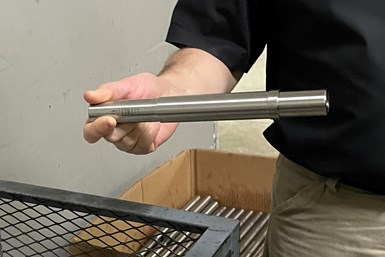
While MTH’s multi-tasking machines can perform the deep drilling vital to producing Freon pump shafts, Tremain describes using the 12”-chuck Integrex to machine a 1”-diameter shaft as “overkill.” As such, the OEM is on the lookout for Swiss-type machines with deep drilling capabilities to produce the part.
Consolidation and Cycle Times
Heading up this standardization and optimization effort is Charlie Ruetsche, a freelancer running the consulting business Refined Manufacturing. Ruetsche is a former Mazak applications engineer, which makes him well-suited for improving the program repeatability and cycle times on MTH’s Integrexes.
Ruetsche’s first refinements for the Freon pump began with MTH’s tool consolidation efforts, during which he programmed the probing operations and experimented with different inserts and geometries to find the best combination of performance and durability for each operation. He also refined the company’s programs using advanced features of its ESPRIT CAM software such as Profit Milling, which creates roughing programs with light radial engagement and full depth of cut to reduce cycle times and improve tool life.
These tooling and programming refinements have added up to massive improvements in cycle time. Reaching a target of 75 Freon pumps per day used to be impossible — even with overnight automation — as machining operations for the casing alone clocked in at 62 minutes per part. Ruetsche’s alterations cut the cycle times for this part nearly in half, making the OEM’s goal achievable with two machines simultaneously working on the part.
According to MTH’s March 2022 data, the company’s automation refinements have resulted in a 60% increase in motor brackets, covers and impellers per labor hour, with more to come.
Stacking a Complete Set
Most of MTH’s gantry loaders utilize either a stacker-style or pallet-style table system. The stacker-style gantry table systems can hold stackable raw material such as impeller blanks, of which it fits up to 320 at a time. The pallet-style gantry table systems with nesting boards hold non-stackable castings such as covers and motor brackets. On most machines, the boards for the pallet-style system can only hold up to 36 parts at once. The machine with the six-axis robot expands the pallet-style system to a drawer-style tray system that feeds non-stackable parts to the gantry robot, which then loads the machine. MTH currently uses this drawer-style system to facilitate production of up to 320 covers or motor brackets at a time for its smallest model of regenerative turbine pump.
While the drawer-style system enables the OEM to produce covers or motor brackets lights-out over the weekend in a one-to-one ratio with impellers, it must still machine the corresponding casing component during the week due to differences in workholding between the cover and the motor bracket. This requires MTH Pumps to keep the two batches of 320 components in inventory until the remaining component batch is complete.
Tremain says the next step of optimizing his company’s workholding setup is ensuring that its covers and motor brackets are made in a fully one-to-one ratio.
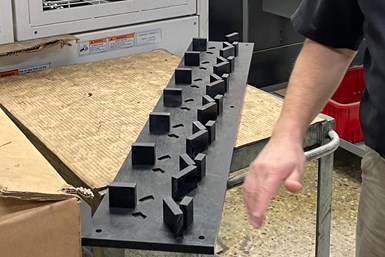
MTH Pumps engineers and machines some of its custom gantry boards in-house.
To do so, the company plans to put more than one component type on each nesting gantry board. While standard gantry boards are not designed for use with multiple parts, MTH is already accustomed to using custom gantry boards with slots to fit part feet. When I visited MTH in March 2022, its in-house engineering staff had developed a prototype pattern for the multi-component gantry board and was making test gantry boards with a small milling center in its toolroom.
Ultimately, MTH hopes both to stage the two halves of a pump casing on the same gantry board and to alternate between them. As long as the workholding and the gantry loader’s grippers are the same between parts — and as long as the machining center holds the proper programming and mix of tooling — this could become a reality. If the OEM can go a step further and add impellers, it would then be able to include a full unit on its gantry boards. This would spark a massive change for MTH Pumps’ inventory, as the company would no longer need to keep a stock of extra parts waiting for the rest of the components.
The P-Factor is the X-Factor
In the period between MTH Pumps’ initial utilization audit and my visit, the OEM had already increased its machine utilization rates from 25% to 30%. A 5% increase may not sound like much, but in conjunction with a 50% cycle time reduction across multiple major components, this has resulted in a major productivity boost.
This stark difference between utilization and cycle time improvements is actually quite normal, says Robert McCrory, MTH’s director of operations. He explains that until demand increases, cycle time reductions can make utilization look unfavorable by reducing the amount of time the machine will need to run for the same output.
Neither utilization nor cycle time by itself is a perfect metric for measuring MTH Pumps’ improvement, then. As a result, McCrory has started to prefer a metric measuring the parts produced per labor hour, which he calls the “P-factor.” According to MTH’s March 2022 data, the company’s automation refinements have resulted in a 60% increase in the P-factor for motor brackets, covers and impellers, with more to come.
“We’ve probably got fewer machinists right now than we did in the ’80’s,” Tremain says, referring to the earliest days of MTH Pumps’ automation efforts. “But we’re easily making 15 times as many parts today.”
Related Content
Inside a CNC-Machined Gothic Monastery in Wyoming
An inside look into the Carmelite Monks of Wyoming, who are combining centuries-old Gothic architectural principles with modern CNC machining to build a monastery in the mountains of Wyoming.
Read More4 Tips for Staying Profitable in the Face of Change
After more than 40 years in business, this shop has learned how to adapt to stay profitable.
Read MoreAddressing Manufacturing Challenges with Automation
GrayMatter Robotics’ Physical AI robotic cells for manufacturing offer immediate impact and results.
Read More10 Robotic Solutions You Can Find at IMTS 2026
Discover how today’s robots and cobots are making it easier than ever to automate tasks, free up skilled workers, and run machines unattended – even in small and midsized shops.
Read MoreRead Next
Esprit Software Keeps Wet Design Agile
The Esprit CAM system has enabled artistic fountain creator Wet Design to increase efficiency and spend its time creating instead of troubleshooting code.
Read MoreMultitasking CNC Machines Cut Down on Work in Process
This pump manufacturer has integrated flexible multitasking machines and automation to maintain high production levels and flexibility.
Read MoreDigitalization and Multitasking Accelerate Prototyping
Protolabs’ Mazak Integrex multitasking machines facilitate efficient automation of the prototyping company's high-mix, low-volume workload.
Read More


























